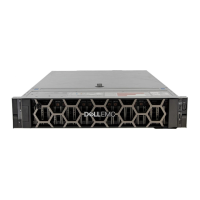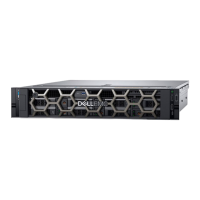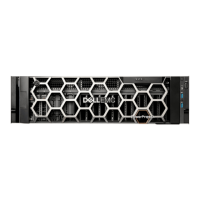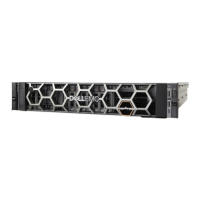Symptom Cause Recommended action
may be causing additional
internal temperature rise.
NOTE: This is not a fault
condition.
reached. This may be caused by
higher ambient temperatures in
the local environment, and may
be perfectly normal.
NOTE: This threshold
changes according to
the number of disks and
power supplies installed.
3 Check for excessive re-circulation of heated air from rear to
front. Use of the enclosure in a fully enclosed rack is not
recommended.
4 Verify that all blank modules are in place.
5 Reduce the ambient temperature.
Thermal alarm
Table 23. Thermal alarm recommended actions
Symptom Cause Recommended action
1 Ops panel Module Fault
LED is amber.
2 Fan Fail LED is illuminated
on one or more PCMs.
Internal temperature exceeds a
preset threshold for the
enclosure.
1 Verify that the local ambient environment temperature is
within the acceptable range. See also Environmental
requirements.
2 Check the installation for any airow restrictions at either the
front or back of the enclosure. A minimum gap of 25 mm (1")
at the front and 50 mm (2") at the rear is recommended.
3 Check for restrictions due to dust build-up. Clean as
appropriate.
4 Check for excessive re-circulation of heated air from rear to
front. Use of the enclosure in a fully enclosed rack is not
recommended.
5 If possible, shut down the enclosure and investigate the
problem before continuing.
Troubleshooting 5U enclosures
The table describes common problems that can occur with your enclosure system, together with possible solutions. For all of the problems
listed in the following table , the Module Fault LED on the Ops panel turns amber to indicate a fault. All alarms will also report using SES.
Table 24. 5U alarm conditions
Status Severity
PSU alert–loss of DC power from a single PSU Fault – loss of redundancy
Cooling module fan failure Fault – loss of redundancy
SBB I/O module detected PSU fault Fault
PSU removed Conguration error
Enclosure conguration error (VPD) Fault – critical
Low temperature warning Warning
High temperature warning Warning
Over-temperature alarm Fault – critical
Troubleshooting and problem solving 41

